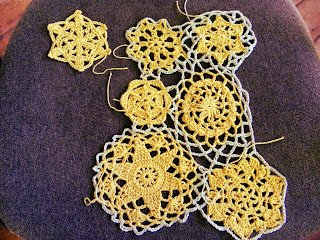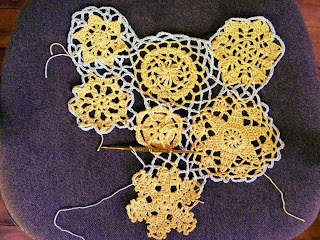“Sundance” is a Crochetology challenge – get various round motifs together to make a blouse. I thought of doing this because I wanted to use a Japanese crochet book of coasters, Christmas tree decorations and motifs to make a garment. This was also the chance to get more used to crocheting a garment without a full pattern, using motifs joined together, a basic method used in Irish crochet and in the new crochet fashion coming from Russia and the Ukraine.
For this project, I used 4-ply cotton yarn and a 2.5mm hook. This is great if you’re new to Irish crochet or joining motifs to make a garment since Irish crochet and the Russian/Ukrainian patterns often ask for fine thread and hook. It is best to practise with the yarn and hook that you are comfortable with before moving onto finer work.
There are various methods in joining motifs or filling in spaces between motifs to create the fabric and shape you need. General methods include starting in the narrow spaces and moving out from there. Often in this method, the motifs are already arranged onto a surface following the desired shape. Such a surface may be a piece of fabric cut out in the shape desired, such as a blouse. Or one may use an existing garment and baste the motifs on that.
The method I use here is more spontaneous. I don’t use a fabric or garment as base. I make all the motifs I like and make a layout that create the shape, then I crochet around a motif and join that to the next one. Some important things:
1. I don’t worry about the edges, they can be as crooked and uneven as they are. I focus on joining the motifs.
2. I don’t worry about large gaps between motifs. The motifs don’t need to fit each other like perfecting a jigsaw puzzle. The gaps are part of the design and can be filled in later if desired.
3. I choose motifs on the basis of their shape (circle, octagon, hexagon), the less spaces around the motif to fill in the better. I choose also on the basis of their size, I prefer large motifs at least 3 inches in diameter as minimum. I avoid motifs that are too heavy or solid.
4. I used 3-ply cotton yarn in natural colour when I ran out of 4-ply yarn, keeping the yarn in the area at the bottom of the blouse, then deciding to use the same yarn to make curved lines all across the blouse in surface crochet. This allows the new yarn to be more integrated with the whole design.
5. Join and fill-in stitches are mostly chain stitches joined with sl st or sc, and sometimes dc or tr for areas where chain stitches are insufficient. Working around the motifs seem to be the easiest way to join them, rather than working at one side of the motif to join to the next.
6. If you’re used to reading and following patterns in crochet, this can be a daunting exercise but you can do it. You can take that hook and yarn anywhere.
























Comments
Post a Comment